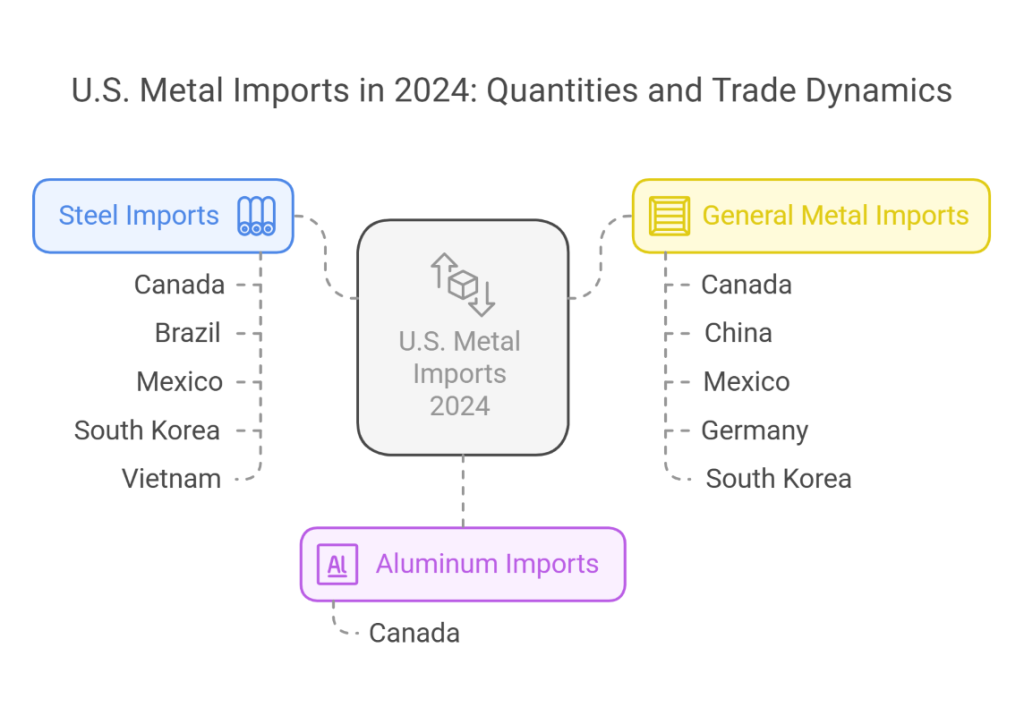President Donald Trump, now in his second term, has made waves once again by announcing plans to impose fresh tariffs on aluminium and steel imports. This move is part of his ongoing effort to put “America First,” aiming to protect domestic industries and reduce reliance on foreign metals. While the administration argues that these tariffs are necessary for national security and economic strength, they’ve sparked heated debates about their potential impact on the U.S. economy, global trade, and key trading partners like Canada, Mexico, and China.
In this article, we’ll break down where things stand with U.S. aluminium and steel imports, what happened when similar tariffs were imposed in the past, and how recent actions by trading partners could shape the fallout from these latest measures.
Where Things Stand with Aluminium and Steel Imports
Even though the U.S. is one of the biggest consumers of aluminium and steel globally, it still depends heavily on imports to meet its needs. According to recent data, in 2024, the U.S. imported around $30 billion worth of steel and $7 billion worth of aluminium. The top suppliers? Canada, Mexico, Brazil, South Korea, and China.

Efforts to boost domestic production haven’t been as successful as hoped. American producers face challenges like higher labor costs, stricter environmental rules, and outdated facilities. Because of this, many manufacturers continue to rely on imported materials to keep their prices competitive.
What Happened Last Time Around?
Back in 2018, during his first term, Trump introduced Section 232 tariffs, slapping a 25% tax on steel and a 10% tax on aluminium imports. The idea was to protect U.S. industries by making foreign metals more expensive. But the results were a mixed bag:
- A Boost for Domestic Producers : At first, the tariffs helped U.S. mills ramp up production and created some new jobs in the steel and aluminium sectors. Prices went up domestically, which benefited local producers.
- Higher Costs for Manufacturers : Industries that rely on steel and aluminium—like carmakers, builders, and energy companies—faced rising costs for raw materials. This made them less competitive and, in some cases, led to layoffs.
- Retaliation from Trading Partners : Countries hit back hard. Canada, Mexico, and the European Union imposed their own tariffs on U.S. goods, targeting products like soybeans, pork, and whiskey. Farmers and other exporters took a big hit, losing billions in sales.
- Supply Chain Chaos : The tariffs disrupted global supply chains, forcing companies to scramble for alternative sources or even move operations outside the U.S. to avoid penalties.
When Former President Biden took office, he kept the tariffs but negotiated exemptions for allies like the European Union, Japan, and the U.K. These adjustments were meant to ease tensions while still protecting domestic industries.
Recent Moves by Trading Partners
Over the past month, tensions between the U.S. and its trading partners have flared up again. Canada, Mexico, and China have all signalled they’re ready to respond if Trump follows through with these new tariffs. Here’s what’s been happening:
Canada and Mexico: Ready to Hit Back
Canada and Mexico, two of the largest suppliers of steel and aluminium to the U.S., aren’t holding back. In January 2025, Canadian officials announced plans to impose tariffs on U.S. exports, targeting agricultural products, machinery, and consumer goods. Mexico has also threatened countermeasures, particularly on industries like automotive and electronics.
This isn’t the first time these countries have retaliated. Back in 2018, both Canada and Mexico responded to Trump’s tariffs with their own taxes on U.S. goods, causing major disruptions in cross-border trade. With the U.S.-Mexico-Canada Agreement (USMCA) still in effect, these latest threats could strain an already delicate trade relationship.
China’s Calculated Response
China, which has long been at odds with the U.S. over trade, is taking a more strategic approach this time around. In early February 2025, Chinese officials announced plans to flood other markets with cheap metals, potentially undercutting U.S. exports. Additionally, Beijing has hinted at escalating tensions in areas like technology and finance, adding another layer of complexity to the situation.
What Could Happen If These Tariffs Go Through?
If President Trump follows through on his plan, the renewed tariffs could have wide-ranging effects on both the U.S. economy and international trade:
1. Effects on the U.S. Economy
- Win for Local Producers : Higher tariffs would likely give U.S.-based steel and aluminium companies a leg up by reducing competition from abroad. Increased profits could lead to reinvestment in plants and equipment, potentially creating more jobs.
- Higher Prices for Consumers but higher job numbers : The cost of goods made with steel and aluminium—like cars, appliances, and construction materials—would likely go up. This could add to inflationary pressures and make life more expensive for everyday Americans. Definitely, it will boost jobs in US Steel and Aluminium sectors.
- Pressure on Manufacturing : Industries that depend on affordable steel and aluminium would face rising costs. For example, automakers might raise car prices to cover the extra expenses, which could hurt sales.
- Uncertainty for Businesses : Companies may hold off on expanding or investing due to unpredictable trade policies, which could slow economic growth over the long haul.
2. Impact on Global Trade
- Strained Relationships with Allies : Imposing tariffs risks upsetting countries that see these moves as protectionist. Nations like Canada and Mexico, which are currently exempt from tariffs, might retaliate by slapping barriers on U.S. goods.
- Shift Toward Regional Supply Chains : To avoid tariffs, companies might speed up efforts to localize supply chains within regions like North America or Europe. While this could reduce dependence on foreign suppliers, it might also fragment global markets and lower efficiency.
- Environmental Concerns : Domestic production often involves older facilities with bigger carbon footprints compared to modern overseas plants. Encouraging local output without addressing sustainability issues could hinder progress toward climate goals.
Who Benefits, Who Loses?
- Winners : U.S. steel and aluminium producers would likely benefit from reduced competition and higher prices. Workers in these industries might see better job prospects.
- Losers : Downstream manufacturers, consumers, and farmers exporting to retaliatory nations would bear the brunt of the tariffs. Developing countries that rely on metal exports to the U.S. could face serious economic setbacks.
President Trump’s decision to impose new tariffs on aluminium and steel reflects his commitment to putting “America First,” focusing on protecting domestic industries at the expense of broader economic considerations. While they might offer short-term relief to struggling U.S. producers, the long-term consequences could outweigh the benefits. Rising costs, strained relationships with allies, and disruptions to global supply chains pose significant risks.
As the world becomes more interconnected, going it alone on trade policy risks isolating the U.S. economically and politically. Policymakers need to carefully balance the pros and cons of protecting domestic industries versus fostering sustainable, inclusive growth. Whether these tariffs ultimately help or hurt the U.S. economy remains to be seen—but it all depends on how well they’re implemented and managed.





